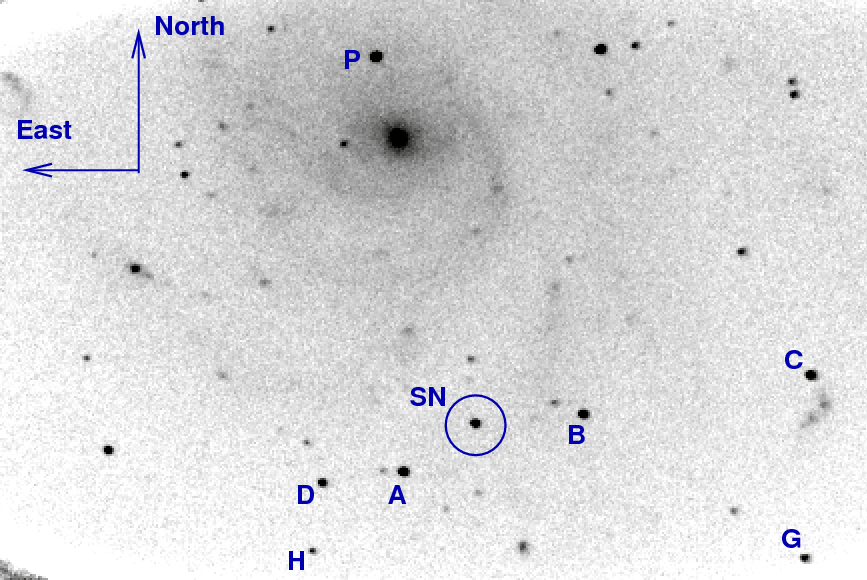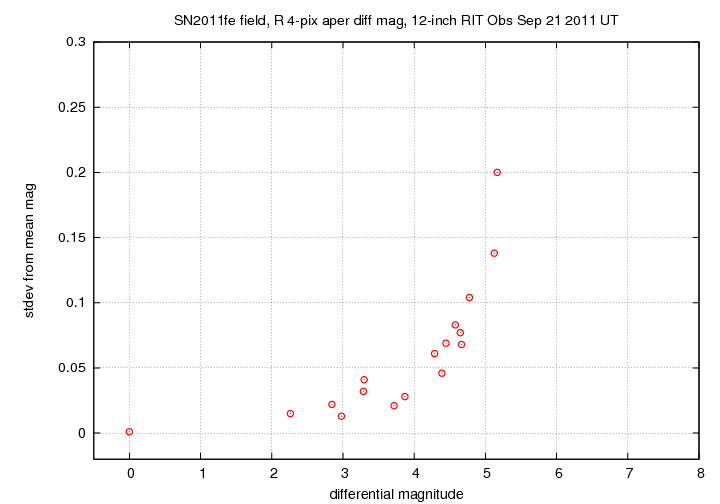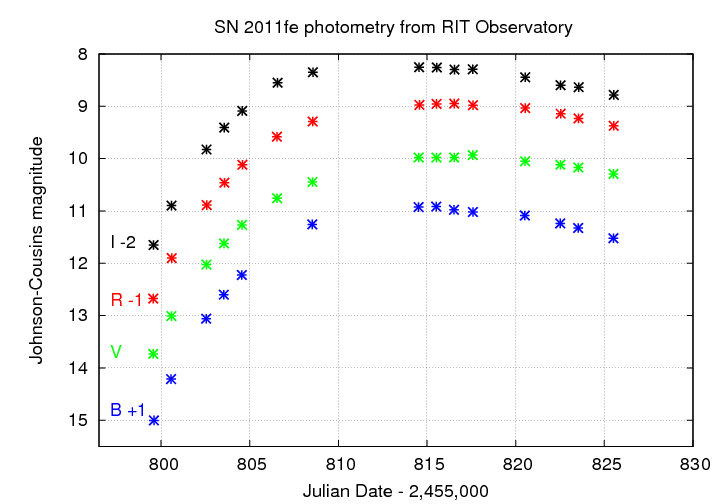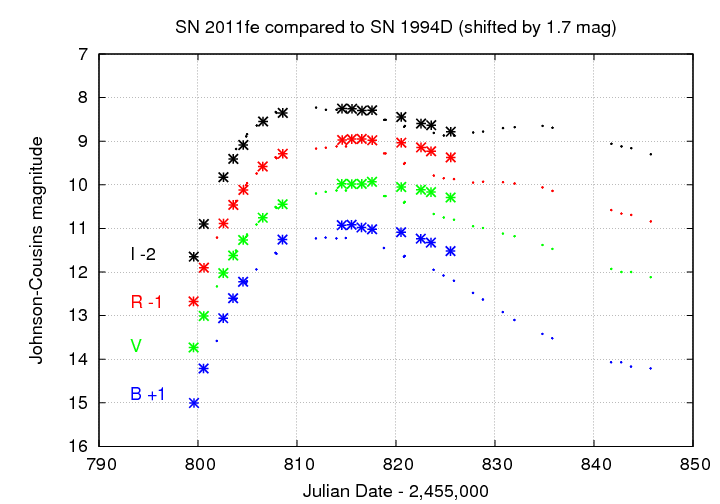
On the night of Sep 20/21, 2011, I observed the newly discovered supernova known as PTF 11kly = SN 2011fe in the galaxy M101.
The setup was:
Notes from the night
This is a chart of the field of SN 2011fe, based on a stack of five R-band images. The field of view is about 10 by 8 arcminutes.

The marked objects appear in a list of comparison stars with magnitudes in BVRI, created by the AAVSO. You can find the original at the AAVSO web site; go to the Variable Star Plotter (VSP) area. I've made a simplified ASCII version of the catalog below, or you can look at the AAVSO's original version in a local copy.
#AUID RA. Dec. Label U B V Rc Ic J H K Comments # Label RA Ra(deg) Dec Dec(deg) ID U B V R I 000-BKD-527 14:03:49.86 [210.95775d] 54:09:05.8 [54.15161d] 117 x - 12.268 (0.057)29 11.735 (0.040)29 11.359 (0.048)29 11.006 (0.054)29 - - - 000-BKD-528 14:04:21.68 [211.09033d] 54:19:22.4 [54.32289d] 119 x - 12.572 (0.068)29 11.948 (0.047)29 11.528 (0.056)29 11.134 (0.063)29 - - - 000-BKD-529 14:02:00.79 [210.50330d] 54:23:15.8 [54.38772d] 128 x - 13.553 (0.062)29 12.751 (0.031)29 12.253 (0.045)29 11.788 (0.056)29 - - - 000-BKD-530 14:01:55.32 [210.48050d] 54:16:21 [54.27250d] 131 x - 13.540 (0.064)29 13.094 (0.044)29 12.716 (0.051)29 12.361 (0.056)29 - - - 000-BKD-531 14:02:02.00 [210.50833d] 54:20:43.9 [54.34553d] 133 x - 14.188 (0.094)29 13.291 (0.057)29 12.772 (0.074)29 12.287 (0.088)29 - - - 000-BKD-532 14:01:49.79 [210.45746d] 54:23:02.7 [54.38408d] 134 x - 14.187 (0.047)29 13.436 (0.033)29 12.970 (0.049)29 12.534 (0.061)29 - - - 000-BKD-533 14:03:13.67 [210.80696d] 54:15:43.4 [54.26205d] 138 A - 14.699 (0.091)29 13.801 (0.046)29 13.230 (0.062)29 12.698 (0.074)29 - - - 000-BKD-534 14:02:54.17 [210.72571d] 54:16:29.5 [54.27486d] 140 B - 14.557 (0.107)29 13.991 (0.074)29 13.581 (0.078)29 13.197 (0.083)29 - - - 000-BKD-535 14:02:29.54 [210.62308d] 54:16:55.2 [54.28200d] 141 C - 14.959 (0.102)29 14.100 (0.045)29 13.598 (0.063)29 13.130 (0.077)29 - - - 000-BKD-536 14:02:31.15 [210.62979d] 54:14:03.9 [54.23442d] 146 G - 15.158 (0.078)29 14.605 (0.029)29 14.204 (0.061)29 13.828 (0.082)29 - - - 000-BKD-540 14:01:50.86 [210.46191d] 54:16:08.1 [54.26892d] 149 x - 15.373 (0.010)29 14.925 (0.000)29 14.635 (0.006)29 14.361 (0.008)29 - - - 000-BKD-538 14:03:23.74 [210.84892d] 54:14:32.6 [54.24239d] 155 H - 16.015 (0.042)29 15.475 (0.000)29 15.133 (0.046)29 14.811 (0.065)29 - - - 000-BKD-539 14:03:05.64 [210.77350d] 54:17:26.2 [54.29061d] 162 x - 16.776 (0.091)29 16.177 (0.000)29 15.640 (0.079)29 15.140 (0.112)29 - - - #Report this sequence as: 5249bgj in the chart field of your observation report. This table is for a 0.25000° fov around PTF11KLY, RA: 14:03:05.81 (210.77421) & Decl.: 54:16:25.40 (54.27372).
I measured the instrumental magnitude of each star with aperture photometry, using a radius of 3 pixels = 4.2 arcseconds in BV, and a radius of 4 pixels = 5.6 arcseconds in RI, and sky defined by an annulus around each star. Following the procedures outlined by Kent Honeycutt's article on inhomogeneous ensemble photometry, I used all stars available in each image to define a reference frame, and measured each star against this frame.
Below is a graph of the scatter in differential magnitude versus magnitude in the ensemble solution for the R-band.

Applying the color corrections determined on UT Aug 27 to the ensemble photometry of SN 2011fe and the comparison stars in its field, I find the magnitude of SN 2011fe on this night was
Passband JD-2,455,000 Mag +/- ------------------------------------------------- B 825.508 10.52 0.10 V 825.517 10.29 0.06 R 825.525 10.37 0.07 I 825.534 10.78 0.07 -------------------------------------------------
The uncertainties here are dominated by the photometry of the reference stars.
I have not yet reported these measurements to the AAVSO via their WebObs tool ....
You can find a complete set of the RIT Obs measurements by grabbing the file sn2011fe_mags.out. I've plotted our measurements in two graphs. First, the measurements of SN 2011fe so far:

Second, the new SN compared to another Type Ia SN, SN 1994D in NGC4526. I've shifted the SN 1994D measurements in time and in magnitude so that they sort of match the early observations of SN 2011fe.

It's clear now that SN 2011fe is declining more slowly than SN 1994D, which was a "Branch normal" Type Ia SN. This suggests that SN 2011fe, as a slowly-declining event, will be more luminous than the usual SN Ia.
As I watched the TV screen showing the video camera's output tonight, it seemed to me that I could see more stars than usual. Perhaps it was clear, perhaps I happened to focus particularly well. In any case, when I was pointing at the field of M101, I was able to see a very faint speck of light, at the edge of visibility, which was (very probably) SN 2011fe. The image below shows the TV screen; two pieces of tape mark the location of the very faint object I believe was SN 2011fe -- it's not really visible in this poor photograph. If you click on the image, you'll see a short animation which overlays a DSS image of the area onto the image. I used the two circled stars to align the DSS image to the screen. The circle at lower left indicates the position of SN 2011fe.
Last modified 9/21/2011 by MWR.